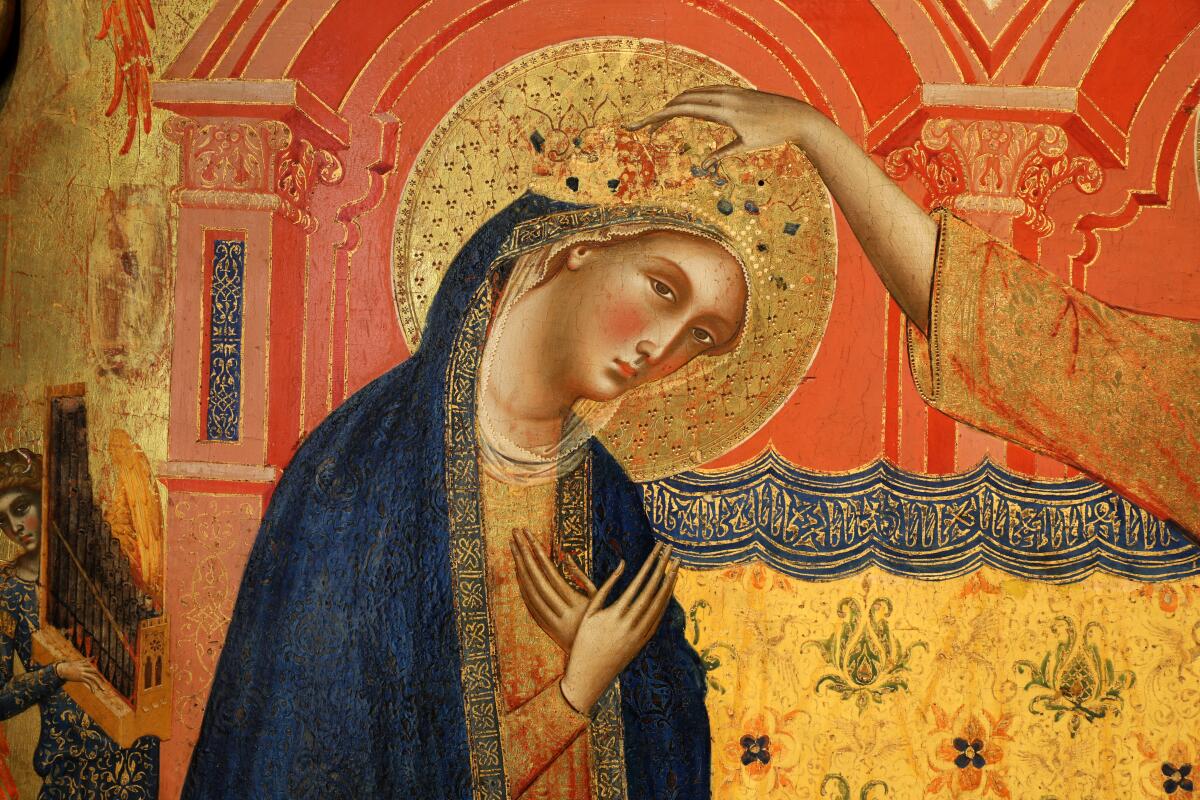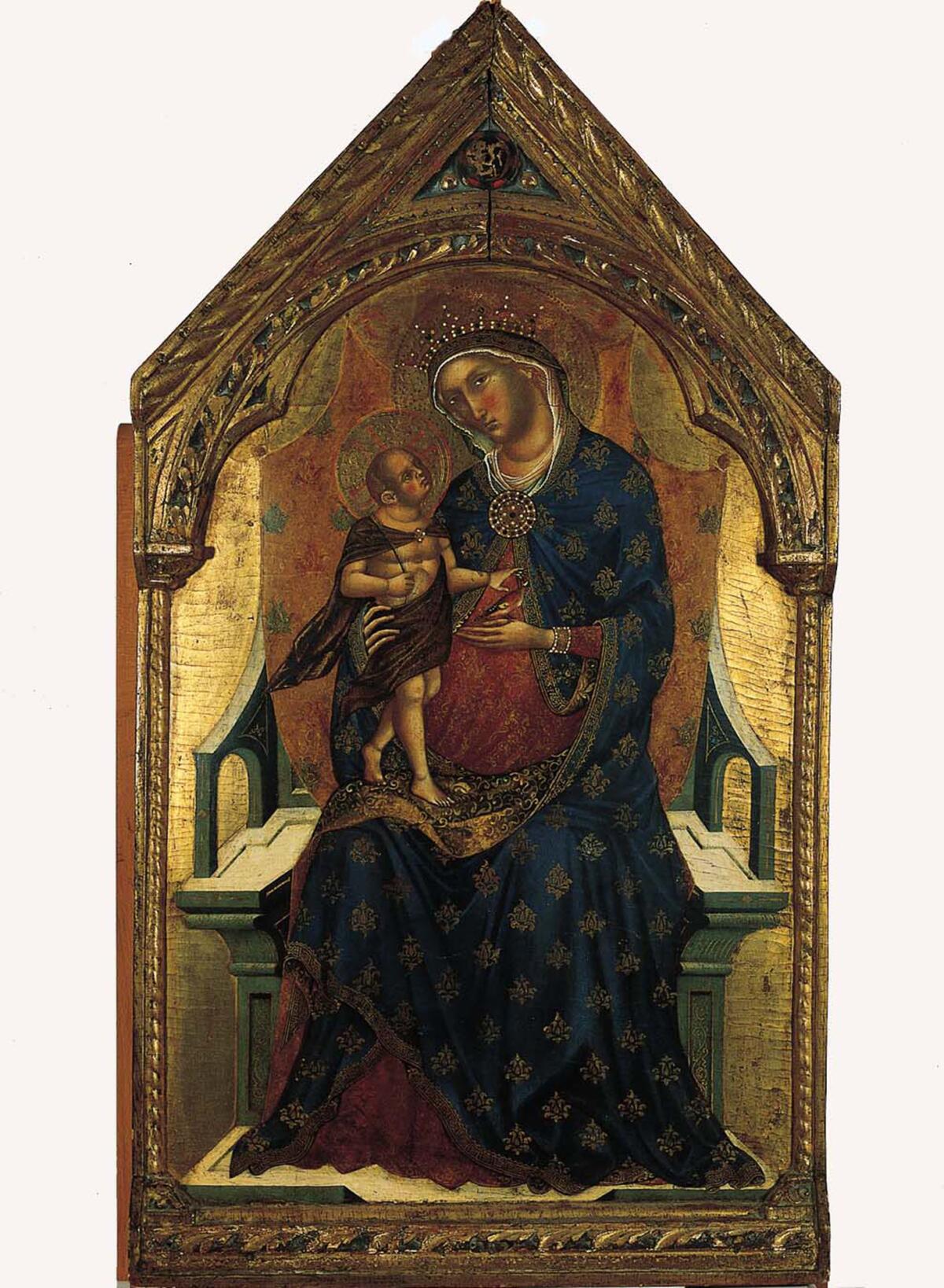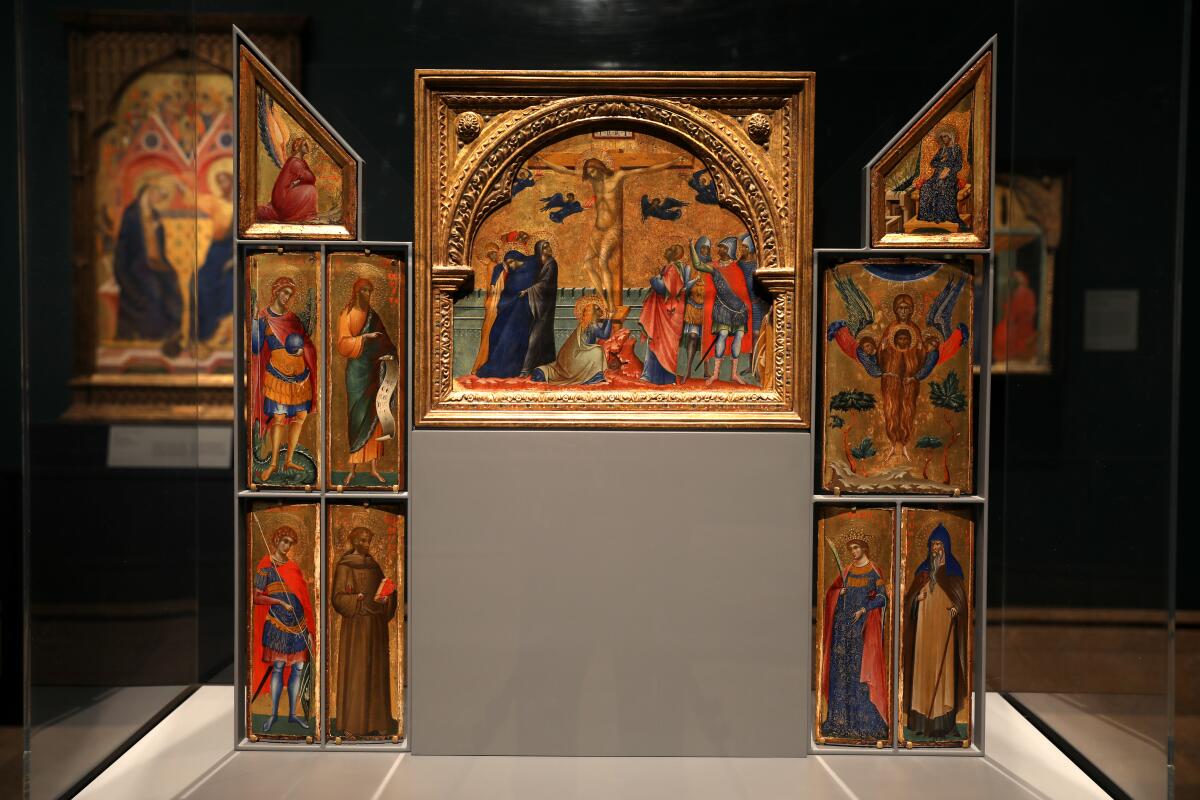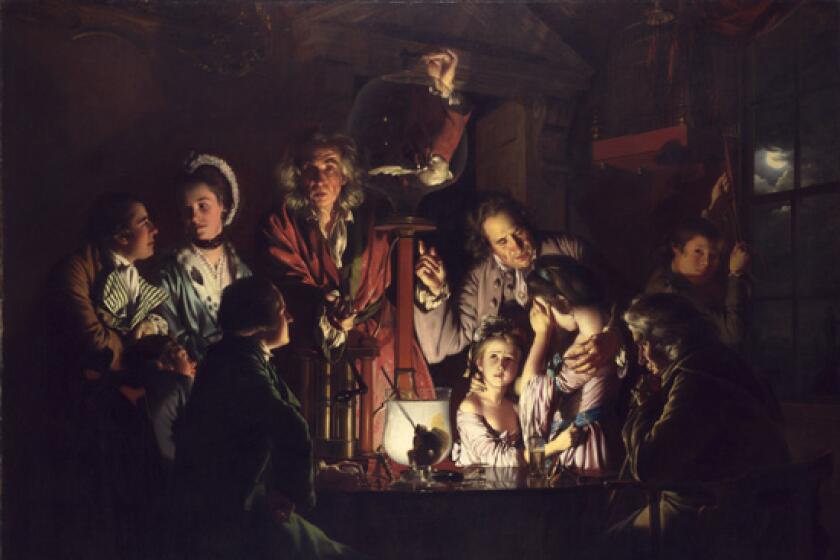Review: The Gettyâs must-see 14th century Venetian art and the mystery that lies within it

Around 1340 or 1345, when he was painting the two multipanel private altarpieces now at the center of a captivating new exhibition at the J. Paul Getty Museum, Paolo Veneziano â Paul the Venetian â could not have known that in just a few short years the great port city on the lagoon would be swamped by the Black Death.
Surely Paolo knew about plagues. Venice was the largest, richest trading city of its day. The broad and busy international traffic among Western Europe, Eurasia and North Africa was ideal for spreading disease at least as well as commercial goods.
Earthly disaster of any kind in fact amplified demand in the market for small religious altarpieces, ideal for private contemplation at a wealthy patronâs home. Altarpiece production was one key to Paoloâs family business.
He was the standout in a multigenerational family of artists that included his father, his brother and three of his sons. (Paolo was born around 1295 and died around 1362.) Judging from the two luxe altarpieces in âPaolo Veneziano: Art & Devotion in 14th-Century Venice,â itâs easy to see why he was in demand.
Many art historians regard the late-medieval artist as the first great painter in a city that would go on to produce some of the greatest in European art history. (Think Giovanni Bellini, Giorgione and Titian.) Exhibitions of his work donât come up often in the United States, which makes this one must-see.
Itâs small but choice â six individual panels plus the two private altars, each about 2 feet square. An exquisite carved ivory, some sumptuous textile fragments and a dazzling manuscript illumination provide fascinating bits of context.

Paoloâs panel paintings do in fact have the general look of being extravagant, formalized, enlarged paintings in Byzantine manuscripts. The saturated color is often luminous and intense. Whether derived from organic sources (insects, mollusks, plants) or inorganic ones (earth, minerals, metals), the bedazzled range of paints familiar to Venice had also been greatly widened by international trade.
Then thereâs all that gold â a Byzantine staple. Opulent garments, the heavenly space occupied by sacred figures, even the elaborately carved wooden frames that establish the transition from our material world to the elusive pictorial vision fabricated by the artist is lavished with the stuff.
Sometimes itâs polished to a smooth sheen; sometimes it features linear incisions and punched dots. Always it gathers light and then disperses it, in sunlight creating illusions of subtle movement and by candlelight ethereal, more dramatic ghostliness.
The big dazzler here is the 4-foot âCoronation of the Virginâ painted by Paolo and his son, Giovanni, and perhaps his best-known work. (Itâs from the collection of New Yorkâs Frick Museum, which published the showâs excellent catalog but had to drop out of presenting the exhibition due to pandemic interruptions.) Blue and red are the most prominent hues. But gold is everywhere.
Itâs the color of the robes worn by the Virgin and Christ, the trim along the serpentine edges of their indigo cloaks, the patterned textile covering the big throne on which they sit, their crowns, their halos, the halos of the angelic orchestra that surrounds them, those 16 musiciansâ instruments, the sun beneath Jesusâ right foot and, not least of all, the entire space where the coronation of the Queen of Heaven is taking place with such celestial fanfare.
Golden light sacralizes the spiritual subject matter. No doubt gold itself also provided certain self-satisfactions for the pictureâs unknown but necessarily rich original patrons.
Gold is of course the color of the finch in the lovely panel of âThe Virgin and Child.â Birds are ancient symbols for the soul, and for Christianity the goldfinch had come to signal resurrection. This one is perched on the finger of regal mom, while her rambunctious boy steps forward to reach for it.
Less flashy than the coronation painting, its plangent rainbow of rich colors is more luxurious. Showered across the rippling, naturalistic folds of the Virginâs deep blue mantle are gold brocaded floral motifs. The Persian textile fragments shown adjacent feature a phoenix motif derived from Chinese mythological birds, demonstrating one possible, cross-cultural source for the kind of garment Paolo chose for the Virgin.

The exhibition catalog describes her robeâs gold pattern as âapplied with a clumsy flatness.â (It almost looks as if painted with a stamp.) For me, however. the flattened grid couldnât be more astute.
The floral pattern is a two-dimensional visual scrim overlaid on the illusionistic, carefully three-dimensional figures of mother and child. In contrast to the imagined otherworldliness of Jesus and Mary enthroned in heaven, the patternâs flatness emphasizes the material physicality of the painting as an object.
Even the drapery hung behind the pair is painted as if it is tacked to points on the pictureâs elaborately carved frame. You could reach out and touch a picture frame, but not a painted drapery.
Paoloâs expert design creates visual tension between two and three dimensions â perfect for the Virgin and Child, who simultaneously occupy heaven and earth. Rather than clumsy, Maryâs mantle embodies the kind of sophisticated visual complexity that made Paolo as great an artist as he is.
In exchange for loaning âThe Blue Boyâ to London, the Huntington is negotiating the loan of a monumental painting by Joseph Wright of Derby.
Curators Laura Llewellyn and John Witty surmise that this gorgeous panel was once at the center of a large altarpiece. Dismantling altars and selling off individual panels piecemeal was a common desecration later undertaken by rapacious art dealers. One of the two fascinating personal altars in the center of their show has been temporarily reassembled, thanks to multiple loans, for the first time.
The other happily survived intact.
The two are remarkably similar. They both feature the same program: a central crucifixion above a Madonna and child, flanked by seven saints painted on side wings and surmounted by the Annunciation â the angel Gabriel to the left, the astonished Virgin to the right.

Even the odd number of saints is repeated: two tiers of two saints on the left wing; one tier of two on the right, with a single saint in a double-wide space above it. Paolo may have found a desirable format for a satisfied altarpiece client and decided, heck, why not do it again?
The fragments of the reconstructed altarpiece were dispersed over the years, ending up at the Worcester Art Museum in Massachusetts (1927), the National Gallery in Washington, D.C. (1939), and the Getty (1987). It is still missing its Madonna and Child, so thereâs a big hole in the center. One painting long thought to have been the likely missing panel is also in the show, but close curatorial examination proved it doesnât fit.
Ironically, thatâs one charming aspect of the show. It pulls a viewer deep into the heads of art historians and curators and what they do, while leaving a piece of the compelling puzzle unanswered.
'Paolo Veneziano: Art and Devotion in 14th-Century Venice'
Where: J. Paul Getty Museum, 1200 Getty Center Drive
When: Tuesdays-Sundays, through Oct. 3
Admission: Free
Info: (310) 440-7300, getty.edu
More to Read
The biggest entertainment stories
Get our big stories about Hollywood, film, television, music, arts, culture and more right in your inbox as soon as they publish.
You may occasionally receive promotional content from the Los Angeles Times.












